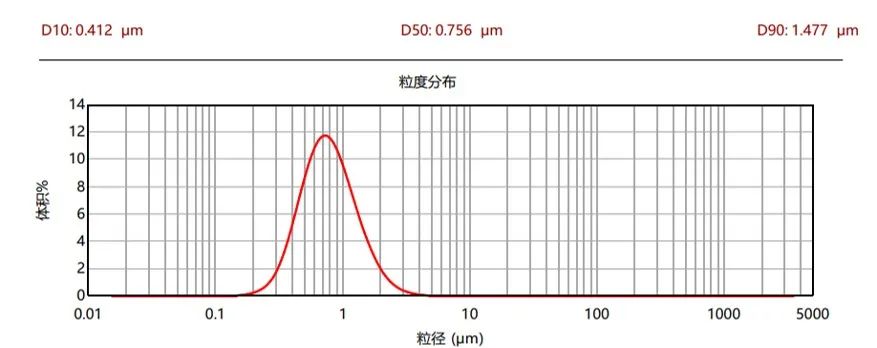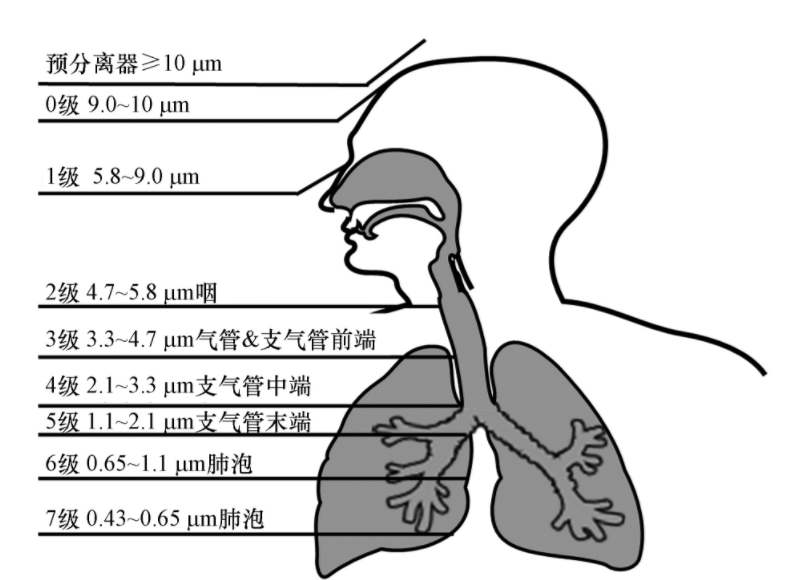Summary:
This article discusses the basic parameters of electronic cigarette aerosols, such as particle size and particle size distribution, as well as the characteristics of aerosol movement and deposition in smoking devices and the respiratory tract. Particle size distribution is typically described using D10, D50, and D90, where D50 represents the median particle size. The movement of aerosols is related to environmental temperature, gas flow rate, and other factors, while their deposition in the respiratory tract is closely related to particle size. The majority of electronic cigarette particles are below 1μm in size, and the method of inhalation (lung inhale or mouth inhale) also affects particle deposition and the effect of nicotine satisfaction.
上一期我们了解了气溶胶的形成演变及输送机制,以及电子烟气溶胶的构成,本期我们将介绍气溶胶的基本参数以及气溶胶在烟具及呼吸道的运动和沉积特点。
Topic 2 气溶胶的基本参数及运动沉积特点
(1)气溶胶的基本参数
粒度:气溶胶粒子的大小,又称粒径,是粒子大小和分布情况的概称;
粒度分布:是指某一粒子群中,不同粒径的粒子所占比例,又称分散度;
D10、D50、D90:粒度分布一般用粒度分布曲线来描述,D表示颗粒直径,D10、D50、D90分别为颗粒累计分布达到10%、50%、90%的粒径,其中D50也叫中值粒径。图1是某雾化器的粒度分布曲线,D50=0.756μm,说明在所有粒径的颗粒中,大于和小于0.756μm的颗粒各占50%。
 图1 某雾化器气溶胶粒度分布曲线
图1 某雾化器气溶胶粒度分布曲线
(2)气溶胶的运动及沉积特点
气溶胶在烟具内部的运动:
雾化面产生的雾化液颗粒与具有一定速度的室温空气相遇,形成气溶胶,经由气道进入使用者口腔。图2为某陶瓷芯雾化器内部气溶胶运动示意图。气溶胶在输送过程中的状态变化与环境温度、气体流速、壁面材质及粗糙度等均有关系。

图2 某陶瓷芯雾化器内部气溶胶运动演示
气溶胶在呼吸道中的沉积:
气溶胶在人体呼吸系统中的沉积规律与粒径息息相关,针对大气中吸入的颗粒,不同粒径的颗粒在呼吸系统的沉积位置如图3所示。
对于电子烟来说,粒径大多集中在1μm以下,另外抽吸方式对于颗粒的沉积影响很大,肺吸时,气溶胶以较快的速度通过口腔,部分颗粒在咽部沉积,形成击喉感,其余粒子直接进入肺部,气体交换后经呼吸道排除,此时气溶胶的浓度相对于吸入时已大幅降低,对鼻腔和口腔感受器的冲击减弱,可能降低对甜度,香味及凉感的感受;口吸时,气溶胶在口腔及鼻腔停留时间较长,对舌面及鼻腔的感受器冲击较强,因此对于甜味的香味的感受更加明显;除此之外,相比于口吸,肺吸过程尼古丁与血液的交换更加充分,因此更具有解瘾效果。关于抽吸方式的介绍可以参考Electronic Cigarette Sensory Evaluation Guide (Part 1): The Puffing Evaluation Method
 图3 粒径分级与人体呼吸系统沉积位置(doi:10.13671/j.hjkxxb.2020.0353)
图3 粒径分级与人体呼吸系统沉积位置(doi:10.13671/j.hjkxxb.2020.0353)
本期与大家一起了解了气溶胶基本参数及运动沉积特点。
下一期我们准备了“气溶胶中不同组分对口感的影响”话题
In the last issue, we learned about the formation, evolution, and transport mechanisms of aerosols, as well as the composition of electronic cigarette aerosols. In this issue, we will introduce the basic parameters of aerosols and the characteristics of aerosol movement and deposition in smoking devices and the respiratory tract.
Topic 2: Basic Parameters of Aerosols and Their Movement and Deposition Characteristics
(1) Basic Parameters of Aerosols
Particle Size: The size of aerosol particles, also known as particle diameter, is a general term for particle size and distribution.
Particle Size Distribution: This refers to the proportion of particles of different sizes within a group of particles, also known as dispersity.
D10, D50, D90: Particle size distribution is generally described by a particle size distribution curve. D represents particle diameter, and D10, D50, and D90 correspond to the particle sizes at which the cumulative distribution reaches 10%, 50%, and 90%, respectively, with D50 also known as the median particle size. Figure 1 shows the particle size distribution curve of a certain atomizer, with D50=0.756μm, indicating that among all particle sizes, particles larger and smaller than 0.756μm each account for 50%.
Figure 1: Particle Size Distribution Curve of a Certain Atomizer's Aerosol
(2) Movement and Deposition Characteristics of Aerosols
Movement of Aerosols Inside the Smoking Device:
The aerosol particles produced by the atomization surface meet the room-temperature air moving at a certain speed, forming an aerosol that enters the user's mouth through the airway. Figure 2 is a schematic diagram of the movement of aerosols inside a certain ceramic core atomizer. The state changes of the aerosol during transportation are related to environmental temperature, gas flow rate, wall material, and roughness.
Figure 2: Demonstration of Aerosol Movement Inside a Certain Ceramic Core Atomizer
Deposition of Aerosols in the Respiratory Tract:
The deposition pattern of aerosols in the human respiratory system is closely related to particle size. For particles inhaled from the atmosphere, the deposition locations of different particle sizes in the respiratory system are shown in Figure 3.
For electronic cigarettes, most particles are concentrated below 1μm in size. Additionally, the method of inhalation has a significant impact on particle deposition. During lung inhale, aerosols pass through the mouth at a fast pace, with some particles depositing in the throat, creating a throat hit sensation, while the remaining particles enter the lungs directly. After gas exchange, they are expelled through the respiratory tract, by which time the aerosol concentration is significantly reduced compared to inhalation, reducing the impact on the receptors in the nose and mouth, which may decrease the perception of sweetness, fragrance, and coolness. During mouth inhale, the aerosols linger longer in the mouth and nose, causing a stronger impact on the receptors on the tongue and in the nasal cavity, thus making the taste and fragrance more pronounced. In addition, compared to mouth inhale, lung inhale allows for more efficient exchange of nicotine with the blood, therefore providing a more effective satisfaction for nicotine cravings. For an introduction to inhalation methods, please refer to the Electronic Cigarette Sensory Evaluation Guide (Part One): Evaluation Methods.
Figure 3: Particle Size Classification and Deposition Locations in the Human Respiratory System (doi:10.13671/j.hjkxxb.2020.0353)
In this issue, we have explored the basic parameters of aerosols and their movement and deposition characteristics.
In the next issue, we have prepared the topic "The Impact of Different Components in Aerosols on Flavor Perception."
原创产品,制作不易,转载请注明出处。感谢各位的订阅和支持!
越多点赞,越多订阅,越多优质内容~~ 欢迎催更!!
原文始发于微信公众号(雾化探秘):Secrets of Electronic Cigarette Flavor: The Aerosol Chapter (Part Two)
电子雾化与HNB产品都是新型电子产品,结构虽小,却融合应用多种材料、表面处理、芯片电子等技术工艺,而且雾化技术一直在不断更迭,供应链在逐步完善,为了促进供应链企业间有一个良好的对接交流,艾邦搭建产业微信群交流平台,欢迎加入;Vape e-cigarettes (VAPE) and Heat-Not-Burn e-cigarettes (HNB) are both emerging electronic products. Despite their compact size, they integrate various materials, surface treatment technologies, chip electronics, and other advanced technical processes. Moreover, atomization technology is constantly evolving and the supply chain is being progressively perfected. To facilitate good communication and networking among supply chain enterprises, Aibang has established an industry WeChat group communication platform and warmly welcomes interested enterprises to join.

